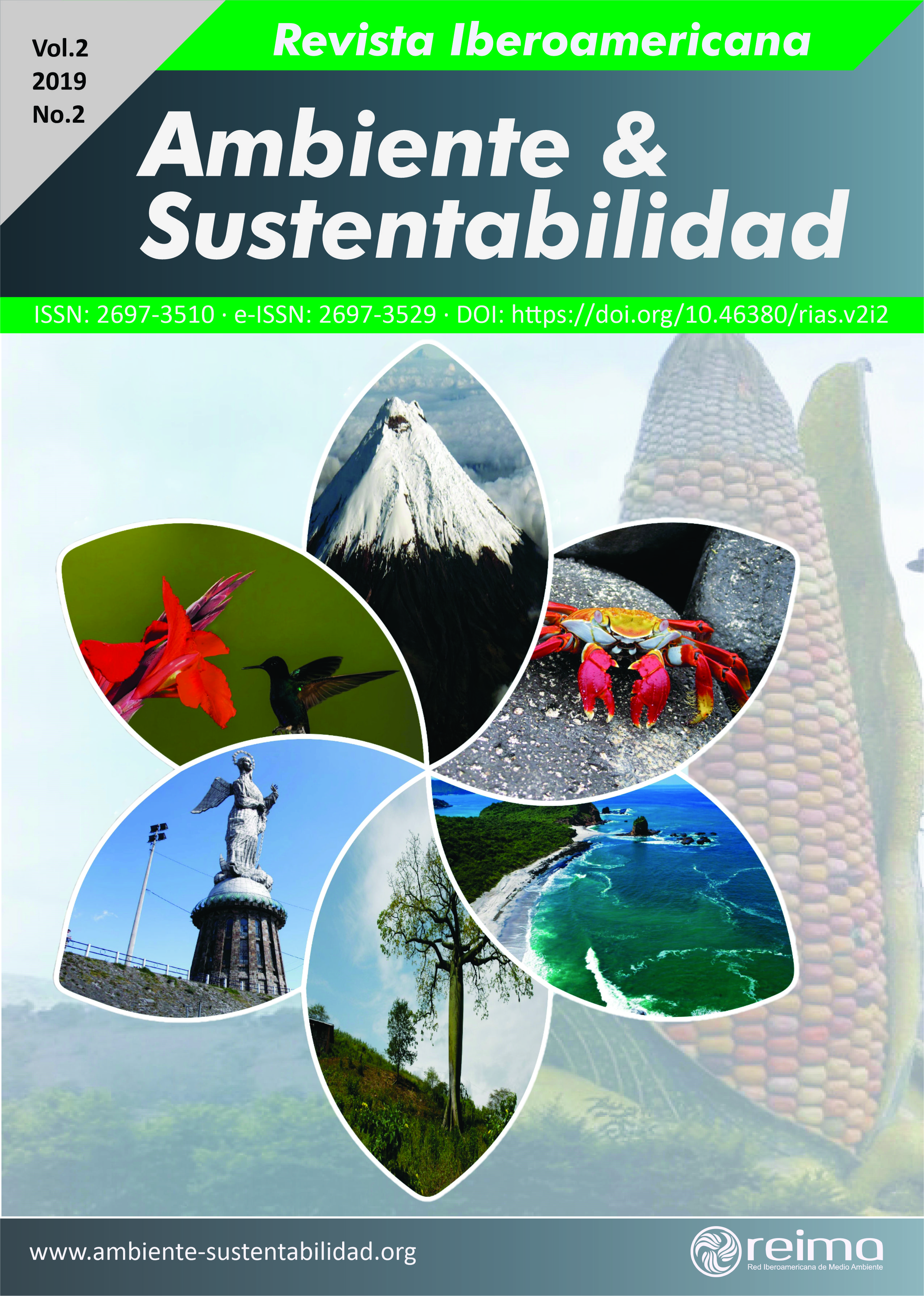Urban Woodland. Case study: County Hermanos Cruz, Pinar del Río, Cuba.
DOI:
https://doi.org/10.46380/rias.v2i2.49Keywords:
diversity, green areas, risk trees, species richnessAbstract
The quality of life of the inhabitants of an urban area depends, to a large extent, on the state and the abundance of green spaces existing in it or in its vicinity. The research presented includes the study carried out in the green areas of the cast Hermanos Cruz, municipality Pinar del Río, with the aim of characterizing the urban trees based on the composition, diversity and perception of the inhabitants about their functions. 11 areas were selected. From the Cuban Standard of Green Areas (NC 677-1: 2009), they were classified according to their location and function; those corresponding to parks and public facilities were inventoried, as well as the tree-lined road. In this regard, the following were identified: risk trees; main conflicts; wealth index; relative frequency; and relative abundance; and surveys were applied to the settlers to know their perception of urban trees. As results of the study it was obtained that, in the distribution of the species by growth habits, a predominance of the trees is observed, highlighting the families Bignoniaceae, Malvaceae, Meliaceae, Caesalpinaceae, Annonaceae and Arecaceae as the most represented. Regarding the origin, the species introduced for both trees and shrubs predominate. Species richness presents a variation between the different areas. People consider the presence of trees in cities necessary and demonstrate knowledge about woodland in their city environment, in terms of their functions and benefits. Proposals are made to increase native species.
Downloads
Metrics
References
Acevedo, P. y Strong, M.T. (2012). Catalogue of Seed Plants of the West Indies. Smithsonian contributions to botany, (98). Smithsonian Institution Scholarly Press https://doi.org/10.5479/si.0081024X.98.1
Álvarez de Zayas, A. (2008). Plantas ornamentales en Cuba: usos, diversidad y amenazas. Revista del Jardín Botánico Nacional, (29), 83-100. https://cutt.ly/efccjQz
Bisse, J. (1988). Árboles de Cuba. Editorial Científico -Técnica.
Chang, J.A. (14 al 17 de abril 2015). Diagnóstico espacial de la cobertura de copas del arbolado público en la ciudad de Palma Soriano [Ponencia]. Convención Internacional Agroforestal 2015. La Habana, Cuba.
Calero, A. (1978). Técnica de muestreo. Editorial Pueblo y Educación.
Castillo, L. y Ferro, S.A. (2015). La problemática del diseño con árboles en vías urbanas: “verde con pespuntes negros”. Arquitectura y Urbanismo, 36(1), 5-24. https://n9.cl/tn41
Iguiñiz, G. (2007). Apuntes de Gestión de la estructura del arbolado urbano [Archivo PDF]. https://cutt.ly/Sfcch95
Ministerio de Ciencia, Tecnología y Medio Ambiente (1978). Áreas verdes (NC 53-05:78). La Habana, Cuba.
Ministerio de Ciencia, Tecnología y Medio Ambiente (1987). Áreas verdes urbanas. Términos y definiciones (NC 93-06-101:87). La Habana, Cuba.
Pérez, M. (2014). Evaluación de las condiciones ambientales de los espacios públicos de Pinar del Río [Tesis de maestría no publicada]. Universidad de Pinar del Río.
Perdomo, D. (2015). El arbolado urbano en San Nicolás: Una visión desde la gestión del conocimiento. [Ponencia]. Convención Internacional Agroforestal 2015. La Habana, Cuba
Sablón, A.M. (1987). Dendrología. Editorial Científico Técnica.
Sosa-López, A., Molina- Pelegrín, Y., Puig-Pérez, A. y Riquenes-Valdés, A. (2011). Diagnóstico de la situación del arbolado urbano en la ciudad de Guisa. Revista Forestal Baracoa, 30(1), 73-78.
Moreno, D., Álvarez, A., Vázquez, L. y Simonetti, J. (2010). Evaluación de atrayentes para la captura de hembras adultas de broca del café Hypothenemus hampei (ferrari) con trampas artesanales. Fitosanidad, 14(3), 177-180. https://cutt.ly/uyAnOcv
Ochoa, A., Marín, J. y Rivero, D. (2013). Caracterización física y química de extractos totales de Petiveria alliacea l. con acción antimicrobiana. Revista mexicana de ciencias farmacéuticas, 44(1), 52-59. https://cutt.ly/eyAn0Tf
Programa Cooperativo Regional para el Desarrollo Tecnológico y Modernización de la Caficultura en Centroamérica, Panamá, República Dominicana y Jamaica. (2007). Manejo Integrado de la broca del café diseñado con tres componentes. https://cutt.ly/Efcchsu
Quemé, J.P. (2013). Control etológico de la broca (Hypothenemus hampei; Scolytinae) del café, Colomba Costa Cuca, Quetzaltenango 2010-2011 [Tesis de Licenciatura, Universidad Rafael Landívar]. https://cutt.ly/Rfccgdn
Ramos, R. (mayo de 2001). Aceite de neem un insecticida ecológico. https://cutt.ly/pfccfZh
Solórzano, J. (2004). Color, tipo de trampas y tipos de señuelo para la captura de la broca del café (Hypothenemus hampei) Ferrari (Coleptera: Curculionidae: Scolitynae) en Costa Rica [Tesis de Maestría, Instituto de Fitosanidad]. https://n9.cl/zpck
Tandazo, A., Cisneros, P., Jaramillo, T. y Espinoza, O. (1997). Control integrado de la broca del café en la región sur del país. Ministerio de Agricultura y Ganadería y Programa de apoyo alimentario, pp. 144.
Valarezo, C.O., Cañarte, B.E. y Navarrete, C.B. (2008). El A. indica insecticida botánico para el manejo de plagas agrícolas (en línea). Boletín divulgativo no. 336. Instituto Nacional de Investigaciones Agropecuarias. https://cutt.ly/yfccfy7
Downloads
Published
How to Cite
Issue
Section
License
Copyright (c) 2019 Marta Margarita Bonilla Vichot, Elizabeth Crespo Paredes, Darien Felipe Medina Bonilla

This work is licensed under a Creative Commons Attribution-NonCommercial-ShareAlike 4.0 International License.
This work is licensed under a Creative Commons Attribution-NonCommercial-ShareAlike 4.0 International License (CC BY-NC-SA 4.0)
© This license allows users to distribute, remix, adapt, and build upon the material in any medium or format, provided that attribution is granted to the creator.














